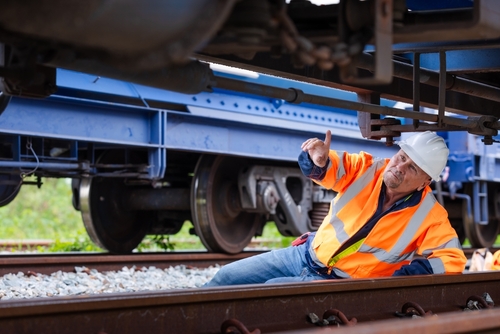
Amid growing concerns about rail safety and inspection standards in the United States, Norfolk Southern recently changed its inspection guidelines to a one-minute target time on railcar inspections, guidance that’s being criticized by the Transportation Communications Union (TCU/IAM).
David Arouca, national legislative director for the union, argues that the railroad company’s new one-minute visual inspections are insufficient for detecting car defects and ensuring safety. They aren’t effective at all, he wrote in an email, because railcars take time to inspect.
“We’ve always said a minimum average (spread across a 50-100 set of cars) would be 3 minutes per car (1:30 per side),” he wrote, noting that the extended time standard allows for a thorough inspection to address issues and adjust to adverse conditions like nighttime or inclement weather.
Arouca said that Norfolk Southern’s one-minute inspection guideline also came alongside another company announcement stating that carmen must “chalk” all the cars (a mechanism to make sure crews are checking all of the critical items that need to be checked on a car to confirm they’ve been viewed) and zip tie air hoses on about 30 percent of cars, tasks that Arouca said will add work and time.
“It’s a classic ‘the beatings will continue until morale improves’ scenario,” he said. “There’s a reason all the carmen at Norfolk Southern went ballistic.”
In contrast, Norfolk Southern’s Senior Communications Manager Heather Garcia told Transportation Today that the company’s one-minute visual inspection guidelines are projections for the time it takes to perform certain tasks, not enforced time limits.
“By no means are employees expected to ignore or disregard safety issues,” she said. “If a problem is spotted, employees are required to address it, either by correcting the issue on site or by pulling the car for further maintenance.”
Garcia said that building projections enables Norfolk Southern to plan things like asset availability and employee scheduling and is an important part of business planning.
She also pointed out that most railcars are owned by shippers or leasing companies, not railroads. And in addition to maintaining their cars, shipping parties must examine cars before offering them to the railroad for transport.
“The projections also help the company hold to account car owners and other parties also responsible for inspection of railcars, ensuring that our teams are not spending unnecessary time making up for deficiencies in maintenance of cars, ultimately, improving safety for our employees,” said Garcia.
Visual inspections are also supplemented with technology, allowing Norfolk Southern to identify and address potential issues that may be difficult to detect with the human eye during stationary inspections, according to Garcia.
For example, wayside detectors placed along the tracks enable the company to monitor freight car and locomotive conditions in real time, while digital train inspection portals capture ultra-high-resolution, 360-degree images of passing railcars, said Garcia, noting that the synchronized cameras snap 1,000 images per railcar.
Identified issues are then promptly flagged and reviewed by experts at Norfolk Southern’s Network Operations Center, ensuring proactive maintenance and immediate handling of any critical defects, she added.
“All of these items — regular maintenance, shipper inspections, railroad inspections and tech-enabled detection tools — combine to ensure rail continues to be the safest way to transport goods over land,” said Garcia.
Arouca is skeptical about the industry’s commitment to such technologies, however, saying companies use them selectively.
“Today, the railroads turn on and off these detectors whenever they want — mostly because they have a backlog of repair work, and don’t want any paper trail of them knowingly sending out defecting cars to roll through communities,” he said.
Additionally, the actual level of deployment and/or upkeep of this technology “is far overstated,” said Arouca, noting that while there are certain detectors being used that look for specific defects — like hot box detectors, kip readers that look for flat spots on wheels by measuring impact pressures, brake sensors, and others — the problem is that these detectors (a) don’t look for 70 percent of federal defects and (b) have zero federal regulations governing their deployment and use, he wrote.
At the federal level, rail safety concerns have prompted legislative action. For instance in July, the Railroad Safety Enhancement Act of 2024, H.R. 8996, was introduced by U.S. Rep. Troy Nehls (R-TX) with the goal of increasing safety requirements, especially for trains transporting hazardous materials.
“This bipartisan legislation will help modernize our nation’s rail network and invest in crucial programs that will enhance our rail network’s safety,” Nehls said when he introduced the measure. “I look forward to working with all my colleagues on both sides of the aisle to get this legislation across the finish line.”
A provision in the proposed bill specifically states that no railroad may limit the time required for an employee to complete a railcar, locomotive, or brake inspection to ensure that each railcar, locomotive, and brake system complies with safety laws and regulations, among other provisions.
H.R. 8996 has bipartisan support, with backing from U.S. Rep. Seth Moulton (D-MA), who introduced a resolution earlier this month to expedite its consideration.
“The East Palestine disaster was a national wake-up call: Congress must finally take action to make our freight rail system safer,” said Moulton. “For too long, the Class 1 railroads have prioritized profits over all else. It’s time for that to end.”
The legislation is also supported by TCU, the International Brotherhood of Teamsters, the Brotherhood of Maintenance of Way Employes, the Brotherhood Of Locomotive Engineers and Trainmen, the Transport Workers Union, the Brotherhood of Railway Carmen, the International Brotherhood of Electrical Workers, SMART-TD, and SMART-MD.
“This bill is a true bipartisan and bicameral effort, and it has the backing of key unions,” Moulton said. “Freight rail is the most efficient and safest way to transport goods across our country, and it provides over 160,000 American jobs, but these improvements are overdue. This bill would ensure that this $80 billion industry operates more safely and efficiently for years to come.”